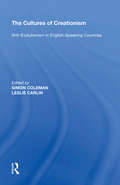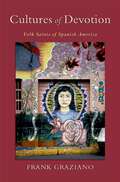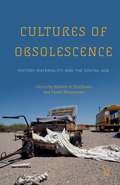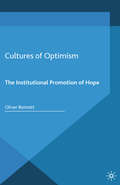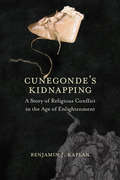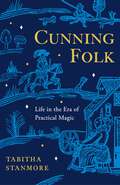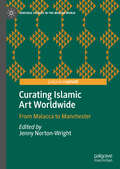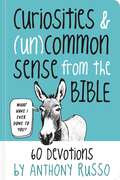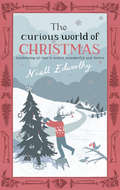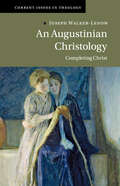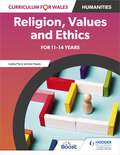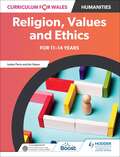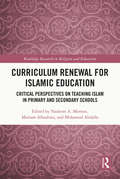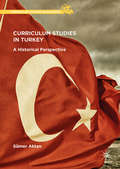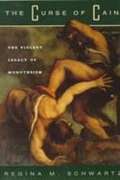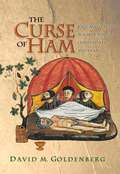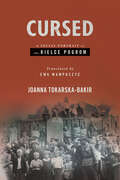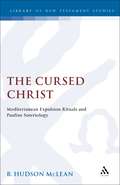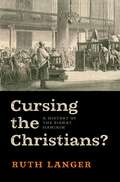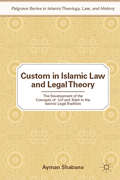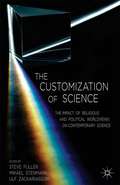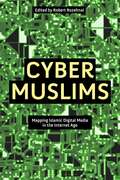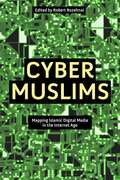- Table View
- List View
The Cultures of Creationism: Anti-Evolutionism in English-Speaking Countries
by Leslie CarlinEven in a world where secular scientific discoveries and assumptions have come to dominate the lives of so many people, science cannot be said to have rendered religion obsolete. Since the nineteenth century, one particular debate has been of central importance in apparent conflicts between science and religion: that of evolutionist versus creationist views on human origins. This book presents both the history and the contemporary dimensions of disputes over the emergence of our species. It focuses on the ways in which conservative Protestants have either opposed or attempted to appropriate the languages and methods of secular scientists in defence of a Genesis-based account of the origins of life. Leading authorities on creationism and creation science are brought together from such disciplines as anthropology, sociology, religious studies, history and philosophy. This is the first book to attempt a comprehensive comparative survey of creationist movements around the English-speaking world. A central question addressed by the contributors is why anti-evolutionist ideas appear to flourish in some social and cultural contexts, but are ridiculed in others.
Cultures of Devotion: Folk Saints of Spanish America
by Frank GrazianoSpanish America has produced numerous "folk saints" -- venerated figures regarded as miraculous but not officially recognized by the Catholic Church. Some of these have huge national cults with hundreds -- perhaps millions -- of devotees. In this book Frank Graziano provides the first overview in any language of these saints, offering in-depth studies of the beliefs, rituals, and devotions surrounding seven representative figures. These case studies are illuminated by comparisons to some hundred additional saints from contemporary Spanish America. Among the six primary cases are Difunta Correa, at whose shrines devotees offer bottles of water and used auto parts in commemoration of her tragic death in the Argentinean desert. Gaucho Gil is only one of many gaucho saints, whose characteristic narrative involves political injustice and Robin-Hood crimes on behalf of the exploited people. The widespread cult of the Mexican saint Nino Fidencio is based on faith healing performed by devotees who channel his powers. Nino Compadrito is an elegantly dressed skeleton of a child, whose miraculous powers are derived in part from an Andean belief in the power of the skull of one who has suffered a tragic death. Graziano draws upon site visits and extensive interviews with devotees, archival material, media reports, and documentaries to produce vivid portraits of these fascinating popular movements. In the process he sheds new light on the often fraught relationship between orthodox Catholicism and folk beliefs and on an important and little-studied facet of the dynamic culture of contemporary Spanish America.
Cultures of Obsolescence: History, Materiality, and the Digital Age
by Babette B. Tischleder Sarah WassermanObsolescence is fundamental to the experience of modernity, not simply one dimension of an economic system. The contributors to this book investigate obsolescence as a historical phenomenon, an aesthetic practice, and an affective mode.
Cultures of Optimism: The Institutional Promotion of Hope
by Oliver BennettWhat are the functions of optimism in modern societies? How is hope culturally transmitted? What values and attitudes does it reflect? This book explores how and why powerful institutions propagate 'cultures of optimism' in different domains, such as politics, work, the family, religion and psychotherapy.
Cunegonde's Kidnapping: A Story of Religious Conflict in the Age of Enlightenment (The Lewis Walpole Series in Eighteenth-Century Culture and History)
by Benjamin J. KaplanIn a remote village on the Dutch-German border, a young Catholic woman named Cunegonde tries to kidnap a baby to prevent it from being baptized in a Protestant church. When she is arrested, fellow Catholics stage an armed raid to free her from detention. These dramatic events of 1762 triggered a cycle of violence, starting a kind of religious war in the village and its surrounding region. Contradicting our current understanding, this war erupted at the height of the Age of Enlightenment, famous for its religious toleration.Cunegonde’s Kidnapping tells in vivid detail the story of this hitherto unknown conflict. Drawing characters, scenes, and dialogue straight from a body of exceptional primary sources, it is the first microhistorical study of religious conflict and toleration in early modern Europe. In it, Benjamin J. Kaplan explores the dilemmas of interfaith marriage and the special character of religious life in a borderland, where religious dissenters enjoy unique freedoms. He also challenges assumptions about the impact of Enlightenment thought and suggests that, on a popular level, some parts of eighteenth-century Europe may not have witnessed a “rise of toleration.”
Cunning Folk: Life in the Era of Practical Magic
by Tabitha Stanmore‘A brilliant book, written with wit and vigour’ MALCOLM GASKILL‘Absolutely fascinating’ IAN MORTIMERTabitha Stanmore transports us to a time when magic was used to navigate life's challenges and solve problems of both trivial and deadly importance.It’s 1600 and you’ve lost your precious silver spoons, or maybe they’ve been stolen. Perhaps your child has a fever. Or you’re facing trial. Maybe you’re looking for love or escaping a husband. What do you do?In medieval and early modern Europe, your first port of call might have been cunning folk: practitioners of ‘service magic’. Neither feared (like witches), nor venerated (like saints), these people were essential: a ubiquitous presence at a time when the supernatural was surprisingly mundane and a cherished everyday resource.We meet lovelorn widows, selfless healers and renegade monks; we listen in on Queen Elizabeth I’s astrology readings and track treasure hunters who try to keep peace with fairies. Much like us, premodern people lived in bewildering times, buffeted by forces beyond their control – and their faith in magic has much to teach us about how we accommodate ourselves to the irrational in our allegedly enlightened lives today.Charming in every sense of the word, Cunning Folk is an immersive reconstruction of a bygone world and a thought-provoking commentary on the beauty and bafflement of being human.
Curating Islamic Art Worldwide: From Malacca to Manchester (Heritage Studies in the Muslim World)
by Jenny Norton-WrightThis volume gives voice to cultural institutions working with collections of Islamic art and material culture globally, including many from outside Western Europe and North America. The contributions inform a vibrant, ongoing global conversation around curatorship in this field, one that embraces the responsibilities, challenges and opportunities for those engaged in it. Contributors—including art historians, curators and education specialists—discuss curatorial methodologies in theoretical and practical terms, present new exhibitions of Islamic art and culture, and explore the role of educational and engagement practices related to Islamic collections and Muslim audiences.
Curiosities and (Un)common Sense from the Bible: 60 Devotions
by Anthony RussoDiscover some of the more quirky people and lesser-known stories of the Bible through sixty devotions.The funny thing about the Bible is that some people say it's the most important book ever written, that it's completely holy and inspired, and others find it strange and audacious. For sixty days, this devotional digs into the curiosities and lesser-known things about the Bible. Through examining the circumstances and biblical truth around each unique story these devotions reveal the heart of God in a more lighthearted way.
The Curious World Of Christmas: Celebrating All That Is Weird, Wonderful, And Festive
by Niall EdworthyDrawing on over 2,000 years of writing and experiences from all over the world, The Curious World of Christmas covers every remarkable aspect of the largest religious festival on Earth. This is a unique treasury of amusing and poignant anecdotes, heart-warming stories, ancient customs, forgotten traditions, historical insights, practical tips, bizarre practices, recipes, quotations and a scattering of jaw-dropping statistics. And while it shuns cloying sentimentality, it is never cynical or contemptuous - The Curious World of Christmas wears its paper hat with pride.Chapters include:Pagan roots of Christmas; Christmas with our ancestors; Christmas around the world; the origins of Santa Claus; Christmas at war; Christmas presents: shopping and DIY; at work on Xmas day; reunions and tantrums; volcanoes, earthquakes and train crashes; Xmas traditions; Xmas weather and Food and Drink - all with a liberal sprinkling of great quotations, and some statistics for good measure.
Current Issues in Theology: Completing Christ (Current Issues In Theology Ser.)
by Joseph Walker-LenowCurriculum for Wales: Religion, Values and Ethics
by Lesley Parry Jan HayesConfidently deliver Religion, Values and Ethics and encourage students to understand and appreciate diverse worldviews, both in Wales and the wider world.This book supports the new Curriculum for Wales for 11-14 years, ensuring that students continually develop their knowledge and skills as they become informed, self-aware and responsible citizens.- Easily design your own curriculum: pick-and-choose from topics that cover the major world faiths and non-religious belief groups, as well as the values and ethical content outlined in the Humanities AoLE- Understand religious and non-religious worldviews and their historical impact: examine the influence of institutional and personal religious and non-religious worldviews on Wales and the wider world throughout history- Bring the content to life in your classroom: explore the beliefs and practices of people living today in Wales and the wider world through real-life accounts and case studies- Encourage critical thinking: each lesson tackles a 'big question' for students to consider, as well as activities designed to allow them to formulate and express their own perspectives and a range of sources to engage them with ethical and moral issues- Develop students' sense of self and their understanding of societal challenges: explore key concepts in the context of different religious and ethical worldviews, including cynefin, identity, relationships, community, equality, sustainability, freedom, good and evil, and more
Curriculum for Wales: Religion, Values and Ethics for 11–14 years
by Lesley Parry Jan HayesConfidently deliver Religion, Values and Ethics and encourage students to understand and appreciate diverse worldviews, both in Wales and the wider world.This book supports the new Curriculum for Wales for 11-14 years, helping students to continually develop their knowledge and skills as they become informed, self-aware and responsible citizens.- Easily design your own curriculum: pick-and-choose from topics that cover the major world faiths and non-religious belief groups, as well as the values and ethical content outlined in the Humanities AoLE- Understand religious and non-religious worldviews and their historical impact: examine the influence of institutional and personal religious and non-religious worldviews on Wales and the wider world throughout history- Bring the content to life in your classroom: explore the beliefs and practices of people living today in Wales and the wider world through real-life accounts and case studies- Encourage critical thinking: each lesson tackles a 'big question' for students to consider, as well as activities designed to allow them to formulate and express their own perspectives and a range of sources to engage them with ethical and moral issues- Develop students' sense of self and their understanding of societal challenges: explore key concepts in the context of different religious and ethical worldviews, including cynefin, identity, relationships, community, equality, sustainability, freedom, good and evil, and more
Curriculum Renewal for Islamic Education: Critical Perspectives on Teaching Islam in Primary and Secondary Schools (Routledge Research in Religion and Education)
by Mohamad Abdalla Nadeem A. Memon Mariam AlhashmiThis book demonstrates why and how it is necessary to redesign Islamic Education curriculum in the K-12 sector globally. From Western public schools that integrate Muslim perspectives to be culturally responsive, to public and private schools in Muslim minority and majority contexts that teach Islamic studies as a core subject or teach from an Islamic perspective, the volume highlights the unique global and sociocultural contexts that support the disparate trajectories of Islamic Education curricula. Divided into three distinct parts, the text discusses current Islamic education curricula and considers new areas for inclusion as part of a general renewal effort that includes developing curricula from an Islamic worldview, and the current aspirations of Islamic education globally. By providing insights on key concepts related to teaching Islam, case studies of curriculum achievements and pitfalls, and suggested processes and pillars for curriculum development, contributors present possibilities for researchers and educators to think about teaching Islam differently. This text will benefit researchers, doctoral students, and academics in the fields of secondary education, Islamic education, and curriculum studies. Those interested in religious education as well as the sociology and theory of religion more broadly will also enjoy this volume.
Curriculum Renewal for Islamic Education: Critical Perspectives on Teaching Islam in Primary and Secondary Schools (Routledge Research in Religion and Education)
by Nadeem A. MemonThis book demonstrates why and how it is necessary to redesign Islamic Education curriculum in the K-12 sector globally. From Western public schools that integrate Muslim perspectives to be culturally responsive, to public and private schools in Muslim minority and majority contexts that teach Islamic studies as a core subject or teach from an Islamic perspective, the volume highlights the unique global and sociocultural contexts that support the disparate trajectories of Islamic Education curricula. Divided into three distinct parts, the text discusses current Islamic education curricula and considers new areas for inclusion as part of a general renewal effort that includes developing curricula from an Islamic worldview, and the current aspirations of Islamic education globally. By providing insights on key concepts related to teaching Islam, case studies of curriculum achievements and pitfalls, and suggested processes and pillars for curriculum development, contributors present possibilities for researchers and educators to think about teaching Islam differently. This text will benefit researchers, doctoral students, and academics in the fields of secondary education, Islamic education, and curriculum studies. Those interested in religious education as well as the sociology and theory of religion more broadly will also enjoy this volume.
Curriculum Studies in Turkey: A Historical Perspective (Curriculum Studies Worldwide)
by Sümer AktanThis book analyzes curriculum studies in Turkey from the perspective of three paradigms—religion, science, and ideology—since the early 19th century. Using Islam as a guiding point, Turkish curriculum theory later evolved to become the classical curriculum theory. In this book, the author presents a historical account of the long, complex, and contested evolution of the Turkish curriculum, as shaped by the intellectual and international forces of the day. This interplay is designed to inform international curriculum studies across national borders.
The Curse of Cain: The Violent Legacy of Monotheism
by Regina M. SchwartzThe Curse of Cain confronts the inherent ambiguities of biblical stories on many levels and, in the end, offers an alternative, inspiring reading of the Bible that is attentive to visions of plenitude rather than scarcity, and to an ethics based on generosity rather than violence. "[A] provocative and timely examination of the interrelationship of monotheism and violence. . . . This is a refreshing alternative to criticism-biblical and otherwise-that so often confuses interpretation with closure; it is an invitation to an ethic of possibility, plenitude, and generosity, a welcome antidote to violence, as important for its insights into memory, identity, and place as for its criticism of monotheism's violent legacy."—Booklist "Brilliant and provocative, this is a work demanding close attention from critics, theologians, and all those interested in the imaginative roots of common life."—Rowan Williams, Bishop of Monmouth "A stunningly important book."—Walter Brueggemann, Theology Today "Artfully rendered, endlessly provocative."—Lawrence Weschler, New Yorker
The Curse of Ham: Race and Slavery in Early Judaism, Christianity, and Islam
by David M. GoldenbergHow old is prejudice against black people? Were the racist attitudes that fueled the Atlantic slave trade firmly in place 700 years before the European discovery of sub-Saharan Africa? In this groundbreaking book, David Goldenberg seeks to discover how dark-skinned peoples, especially black Africans, were portrayed in the Bible and by those who interpreted the Bible--Jews, Christians, and Muslims. Unprecedented in rigor and breadth, his investigation covers a 1,500-year period, from ancient Israel (around 800 B.C.E.) to the eighth century C.E., after the birth of Islam. By tracing the development of anti-Black sentiment during this time, Goldenberg uncovers views about race, color, and slavery that took shape over the centuries--most centrally, the belief that the biblical Ham and his descendants, the black Africans, had been cursed by God with eternal slavery. Goldenberg begins by examining a host of references to black Africans in biblical and postbiblical Jewish literature. From there he moves the inquiry from Black as an ethnic group to black as color, and early Jewish attitudes toward dark skin color. He goes on to ask when the black African first became identified as slave in the Near East, and, in a powerful culmination, discusses the resounding influence of this identification on Jewish, Christian, and Islamic thinking, noting each tradition's exegetical treatment of pertinent biblical passages. Authoritative, fluidly written, and situated at a richly illuminating nexus of images, attitudes, and history, The Curse of Ham is sure to have a profound and lasting impact on the perennial debate over the roots of racism and slavery, and on the study of early Judaism, Christianity, and Islam.
The Curse of Ham: Race and Slavery in Early Judaism, Christianity, and Islam (Jews, Christians, and Muslims from the Ancient to the Modern World #19)
by David M. GoldenbergHow old is prejudice against black people? Were the racist attitudes that fueled the Atlantic slave trade firmly in place 700 years before the European discovery of sub-Saharan Africa? In this groundbreaking book, David Goldenberg seeks to discover how dark-skinned peoples, especially black Africans, were portrayed in the Bible and by those who interpreted the Bible--Jews, Christians, and Muslims. Unprecedented in rigor and breadth, his investigation covers a 1,500-year period, from ancient Israel (around 800 B.C.E.) to the eighth century C.E., after the birth of Islam. By tracing the development of anti-Black sentiment during this time, Goldenberg uncovers views about race, color, and slavery that took shape over the centuries--most centrally, the belief that the biblical Ham and his descendants, the black Africans, had been cursed by God with eternal slavery. Goldenberg begins by examining a host of references to black Africans in biblical and postbiblical Jewish literature. From there he moves the inquiry from Black as an ethnic group to black as color, and early Jewish attitudes toward dark skin color. He goes on to ask when the black African first became identified as slave in the Near East, and, in a powerful culmination, discusses the resounding influence of this identification on Jewish, Christian, and Islamic thinking, noting each tradition's exegetical treatment of pertinent biblical passages. Authoritative, fluidly written, and situated at a richly illuminating nexus of images, attitudes, and history, The Curse of Ham is sure to have a profound and lasting impact on the perennial debate over the roots of racism and slavery, and on the study of early Judaism, Christianity, and Islam.
Cursed: A Social Portrait of the Kielce Pogrom
by Joanna Tokarska-BakirIn Cursed, Joanna Tokarska-Bakir investigates the July 4, 1946, Kielce pogrom, a milestone in the periodization of the Jewish diaspora. This massacre compelled thousands of Polish Jews who survived the Holocaust to flee postwar Poland. It remains a negative reference point in the Polish historical narrative and represents a lack of reckoning with the role of antisemitism in postwar Polish society and identity politics. Tokarska-Bakir weaves together the voices of the Kielce pogrom survivors, witnesses, and perpetrators with a myriad of other archival sources. Her meticulous research exposes wartime and postwar biographies of local factory workers, city and church officials, local police officers, and members of the security service, some of whom participated in the Holocaust and then directly or indirectly participated in the Kielce pogrom. Tokarska-Bakir paints a social portrait that explores people's behavior in light of forces and emotions greater than themselves. She reconstructs a postwar communist system that, despite promises to combat deeply rooted antisemitism, not only failed to prevent its spread but turned a blind eye to it and eventually used it to legitimize itself. Cursed is a microhistory that recreates the events of the Kielce pogrom step by step and examines the dominant hypotheses about the pogrom through the prism of previously classified archival evidence. It offers readers a nuanced analysis that cuts across social and ideological divisions. The resulting narrative is filled with new discoveries not only about the Kielce pogrom but about the nature of antisemitism, hostility toward minorities, and collective violence.Published in Association with the United States Holocaust Memorial Museum.
The Cursed Christ: Mediterranean Expulsion Rituals and Pauline Soteriology (The Library of New Testament Studies #126)
by Bradley H. McLeanIn the first part of this study, McLean deals with Paul's letters synchronically, critiquing the traditional sacrificial interpretation of Paul's atonement theology and offering an alternative model, previously unexplored in scholarship; the argument is not genealogical, but analogical, drawing on the work of Jonathan Z. Smith. In the second part, McLean describes and builds on the method of John Hurd, studying the development of Paul's soteriology diachronically; Paul's letters are examined in chronological order, and the sociological factors that contributed to each development are examined. Finally, Paul's soteriology is placed against the broader canvas of early Christianity, especially the communities associated with Q and the Gospel of Thomas.
Cursing the Christians?: A History of the Birkat HaMinim
by Ruth LangerRuth Langer offers an in-depth study of the birkat haminim, a Jewish prayer for the removal of those categories of human being who prevent the messianic redemption and the society envisioned for it. In its earliest form, the prayer cursed Christians, apostates to Christianity, sectarians, and enemies of Israel. Drawing on the shifting liturgical texts, polemics, and apologetics concerning the prayer, Langer traces the transformation of the birkat haminim from what functioned without question in the medieval world as a Jewish curse of Christians, through its early modern censorship by Christians, to its modern transformation within the Jewish world into a general petition that God remove evil from the world. Christian censorship played a crucial role in this transformation of the prayer; however, Langer argues that the truest transformation in meaning resulted from Jewish integration into Western culture. Eventually, the prayer shed its references to any specific category of human being and lost its function as a curse. Reconciliation between Jews and Christians today requires both communities to confront a long history of prejudice. Ruth Langer shows through the birkat haminim how the history of one liturgical text chronicled Jewish thinking about Christians over hundreds of years.
Custom in Islamic Law and Legal Theory: The Development of the Concepts of ?Urf and ??dah in the Islamic Legal Tradition (Palgrave Series in Islamic Theology, Law, and History)
by Ayman ShabanaThis book explores the relationship between custom and Islamic law and seeks to uncover the role of custom in the construction of legal rulings. On a deeper level, however, it deals with the perennial problem of change and continuity in the Islamic legal tradition (or any tradition for that matter).
The Customization of Science: The Impact of Religious and Political Worldviews on Contemporary Science
by Steve Fuller Mikael Stenmark Ulf ZackariassonThis collection explores whether and how religious and secular worldviews and political ideologies held by scientists, citizens, decision-makers and politicians influence science as practiced and understood today. Contributors explore the social and scientific repercussions of 'customizing' science to fit the needs and interests of various groups.
Cyber Muslims: Mapping Islamic Digital Media in the Internet Age
by Robert RozehnalThrough an array of detailed case studies, this book explores the vibrant digital expressions of diverse groups of Muslim cybernauts: religious clerics and Sufis, feminists and fashionistas, artists and activists, hajj pilgrims and social media influencers. These stories span a vast cultural and geographic landscape-from Indonesia, Iran, and the Arab Middle East to North America. These granular case studies contextualize cyber Islam within broader social trends: racism and Islamophobia, gender dynamics, celebrity culture, identity politics, and the shifting terrain of contemporary religious piety and practice. The book's authors examine an expansive range of digital multimedia technologies as primary “texts.” These include websites, podcasts, blogs, Twitter, Facebook, Instagram, YouTube channels, online magazines and discussion forums, and religious apps. The contributors also draw on a range of methodological and theoretical models from multiple academic disciplines, including communication and media studies, anthropology, history, global studies, religious studies, and Islamic studies.
Cyber Muslims: Mapping Islamic Digital Media in the Internet Age
Through an array of detailed case studies, this book explores the vibrant digital expressions of diverse groups of Muslim cybernauts: religious clerics and Sufis, feminists and fashionistas, artists and activists, hajj pilgrims and social media influencers. These stories span a vast cultural and geographic landscape-from Indonesia, Iran, and the Arab Middle East to North America. These granular case studies contextualize cyber Islam within broader social trends: racism and Islamophobia, gender dynamics, celebrity culture, identity politics, and the shifting terrain of contemporary religious piety and practice. The book's authors examine an expansive range of digital multimedia technologies as primary “texts.” These include websites, podcasts, blogs, Twitter, Facebook, Instagram, YouTube channels, online magazines and discussion forums, and religious apps. The contributors also draw on a range of methodological and theoretical models from multiple academic disciplines, including communication and media studies, anthropology, history, global studies, religious studies, and Islamic studies.
